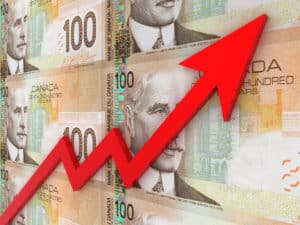Last week, Metro, Inc. (TSX: MRU) released its Q3 2014 earnings report. On the day of the release, the stock dropped 2.5%. Since then, it has bounced backed nicely.
Overall revenue grew 1.4% to $3.6 billion, while same-store sales grew 1%. Net earnings stayed flat at $144.5 million compared to a year earlier. Flat earnings and higher revenue imply a lower margin. Indeed, management attributed lower profitability to a decreased gross margin driven by merchandising actions to drive sales.
Moving forward, what may be some of the catalysts driving Metro?
A strong balance sheet
As of July, Metro had $915.2 million in long-term debt and slightly over $5 billion in total assets for a long-term debt to assets ratio of 18.2%.
Comparatively, Loblaw Companies Limited’s (TSX: L) long-term debt to assets ratio as of June is 35.3%, while Empire Company Limited’s (TSX: EMP.A) long-term debt to assets ratio is 26.8% as of May. For added comparison, U.S.-based food retailer The Kroger Co. (NYSE: KR) has a long-term debt to assets ratio of 33.4%.
This implies that Metro could potentially reach a ratio of 30% comfortably. A ratio of 30% would imply that Metro could carry $1.5 billion of long-term debt, or an increase of $585 million of debt.
At $585 million, assuming it retires its shares at $70, Metro would be able to buy back another 8.35 million shares, which is about 9.5% of existing outstanding shares. As a result, its outstanding share count would decrease from 87.8 million as of March 2014 to 79.5 million. Assuming that operational efficiencies offset any increase in interest expense and that net earnings continue to stay flat at $144.5 million, the company’s earnings per share would be $1.82. This figure of $1.82, compared to the company’s current Q3 EPS of $1.63, implies another 11.7% upside on earnings.
This is the power of a strong balance sheet.
A transformational merger
Another way Metro can leverage its strong balance sheet is to pursue a transformation merger by acquiring The Jean Coutu Group (PJC) Inc. (TSX: PJC.A). Metro’s current market cap is slightly greater than $6 billion, and Jean Coutu’s market cap is trading at slightly above $4 billion. While there may be significant synergies that may be realized, it will not be a bargain price.
Assuming a minimum premium of 25% to 30% to the existing market cap, investors are looking at a take-out value of $5 billion to $5.2 billion. Assuming a split down middle at $5.1 billion, it would still be a mammoth acquisition for Metro.
To make this deal work, a significant portion of the transaction needs to be equity-funded. At 40% equity and 60% debt, this acquisition looks more plausible. Assuming no synergy, a company that combined Metro and Jean Coutu would be easily worth $10 billion.
I like Jean Coutu, as it is an excellent company with no debt. This could be the next Loblaw/Shoppers Drug Mart combo with a dominant presence in Quebec.
Metro’s investment position in Alimentation Couche-Tard Inc
Last year, Metro sold almost half of its position in Alimentation Couche-Tard Inc (TSX: ATD.B). At the end of 2013, Metro owned 10.7 million shares in Couche-Tard. Since then, it has split its shares three for one. Thus, Metro now owns 32.1 million shares; at about $31 a share, its stake is worth close to $1 billion at current valuations.
While investors cannot speculate about what exactly management will do with this stake, we do know that Couche-Tard continues to focus on growth through acquisitions. While there are rumours that it may take a stake in China’s Sinopec Shanghai Petrochemical Co. (ADR) (NYSE:SHI), regardless of whether it makes such a purchase, this is a hidden unrealized asset sitting on Metro’s balance sheet.
Ultimately, while Metro may not be the most exciting investment in your portfolio, you can sleep well at night. With a forward 2014 P/E ratio of under 14 and a strong balance sheet that could be utilized in a variety of ways, Metro has multiple ways to further drive value for shareholders.








